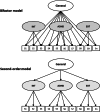Hierarchical models of psychopathology: empirical support, implications, and remaining issues
- PMID: 33432749
- PMCID: PMC7801849
- DOI: 10.1002/wps.20824
Hierarchical models of psychopathology: empirical support, implications, and remaining issues
Abstract
There is an ongoing revolution in psychology and psychiatry that will likely change how we conceptualize, study and treat psychological problems.- Many theorists now support viewing psychopathology as consisting of continuous dimensions rather than discrete diagnostic categories. Indeed, recent papers have proposed comprehensive taxonomies of psychopathology dimensions to replace the DSM and ICD taxonomies of categories. The proposed dimensional taxonomies, which portray psychopathology as hierarchically organized correlated dimensions, are now well supported at phenotypic levels. Multiple studies show that both a general factor of psychopathology at the top of the hierarchy and specific factors at lower levels predict different functional outcomes. Our analyses of data on a large representative sample of child and adolescent twins suggested the causal hypothesis that phenotypic correlations among dimensions of psychopathology are the result of many familial influences being pleiotropic. That is, most genetic variants and shared environmental factors are hypothesized to non-specifically influence risk for multiple rather than individual dimensions of psychopathology. In contrast, person-specific experiences tend to be related to individual dimensions. This hierarchical causal hypothesis has been supported by both large-scale family and molecular genetic studies. Current research focuses on three issues. First, the field has not settled on a preferred statistical model for studying the hierarchy of causes and phenotypes. Second, in spite of encouraging progress, the neurobiological correlates of the hierarchy of dimensions of psychopathology are only partially described. Third, although there are potentially important clinical implications of the hierarchical model, insufficient research has been conducted to date to rec-ommend evidence-based clinical practices.
Keywords: Psychopathology; bifactor model; dimensions; externalizing; general factor of psychopathology; hierarchical approach; internalizing; second-order model.
© 2021 World Psychiatric Association.
Figures
References
-
- Achenbach TM. Classification of children’s psychiatric symptoms: a factor analytic study. Psychol Monogr 1966;80:1‐37. - PubMed
-
- Achenbach TM, Conners CK, Quay HC et al. Replication of empirically derived syndromes as a basis for taxonomy of child and adolescent psychopathology. J Abnorm Child Psychol 1989;17:299‐323. - PubMed
-
- Quay HC. Classification In: Quay HC, Werry JS. (eds). Psychopathological disorders of childhood, 3rd ed. New York: Wiley, 1986:1‐42.
-
- Quay HC, Quay LC. Behavior problems in early adolescence. Child Develop 1965;36:215‐20. - PubMed
Grants and funding
LinkOut - more resources
Full Text Sources
Other Literature Sources


